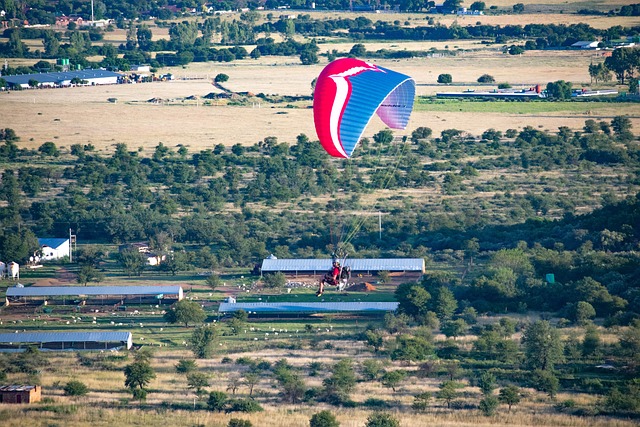Paramotors are an exciting and adventurous way to explore the skies. However, many people wonder whether it is legal and safe to fly a paramotor over a city. As a knowledgeable person on the topic of paramotors, I can assure you that this is an important question to address.
Whether or not you can fly a paramotor over a city depends on the laws and regulations of the specific city and the Federal Aviation Administration (FAA) regulations. Flying a paramotor over a city comes with significant risks and challenges, and pilots must prioritize safety and follow best practices to ensure the safety of themselves and others in the area.
In this article, I will explore the laws and regulations surrounding flying a paramotor over a city, the risks and challenges that come with it, safety precautions and best practices to follow, as well as alternatives to flying over a city. Whether you’re a seasoned paramotor pilot or just starting out, this article will provide you with the information you need to make informed decisions about flying a paramotor over a city.
Understanding the Law
Flying a paramotor over a city is subject to various laws and regulations, both at the federal and local levels. The Federal Aviation Administration (FAA) has jurisdiction over all airspace in the United States, including the airspace above cities. According to the FAA, paramotors are classified as ultralight vehicles and fall under Part 103 of the FAA regulations.
Under Part 103, there are several rules that pilots must follow when flying a paramotor, including:
- Flying only during daylight hours
- Flying no higher than 18,000 feet above sea level
- Flying only in uncontrolled airspace
- Flying no closer than 500 feet to any person, vessel, vehicle, or structure
In addition to federal regulations, there may be local laws and regulations that govern flying a paramotor over a city. Pilots should research and comply with any local laws and regulations before taking off.
It’s important to note that flying a paramotor in controlled airspace (such as near airports) requires additional clearance and permission from air traffic control. Pilots should also be aware of temporary flight restrictions, which may be put in place for events or emergencies.
In short, flying a paramotor over a city is subject to various laws and regulations, including federal and local laws. Pilots should familiarize themselves with these laws and regulations before taking off to ensure compliance and safety.
Risks and Challenges of Flying a Paramotor over a City
Flying a paramotor over a city comes with significant risks and challenges that pilots must consider before taking off. Some of the most notable risks and challenges include:
- Crowded airspace and risk of collision with other aircraft: Cities often have busy airspace with many other aircraft, including helicopters, planes, and drones. Pilots must be aware of other aircraft in the area and take appropriate measures to avoid collisions.
- Risk of injury to people on the ground: Flying a paramotor over a city means flying over densely populated areas, putting people on the ground at risk of injury in the event of an accident or equipment failure.
- Noise pollution and disturbance to residents: Paramotors can be loud and disruptive, causing noise pollution and disturbing residents in the areas below. This can result in complaints and legal issues for pilots.
- Challenges of navigating through buildings and other obstacles: Cities are full of obstacles, including buildings, power lines, and other structures that can be challenging to navigate around. Pilots must be skilled and experienced enough to safely navigate through these obstacles.
It’s crucial for pilots to carefully consider these risks and challenges before deciding to fly a paramotor over a city.
Safety Precautions and Best Practices
Flying a paramotor over a city requires taking specific safety precautions and following best practices to ensure the safety of everyone involved. Some of the most important safety precautions and best practices to consider include:
- Choosing the right time and location to fly: Pilots should choose a time and location that is less crowded and has minimal risk of disturbing residents or other aircraft.
- Proper equipment and training: It’s essential to use properly maintained equipment and receive adequate training to ensure that pilots have the necessary skills and knowledge to operate a paramotor safely.
- Communication with local authorities and residents: Pilots should communicate with local authorities and residents to inform them of their flight plans and minimize any potential disturbances or hazards.
- Awareness of weather conditions: Pilots should pay close attention to weather conditions, including wind speed, direction, and potential storms, to ensure that they are flying in safe conditions.
It’s essential to prioritize safety and always take necessary precautions before taking off.
Alternatives to Flying over a City
While flying a paramotor over a city can be an exciting prospect, there are many alternatives to consider that may provide a safer and more enjoyable flying experience. Some of the most popular alternatives include:
- Flying in rural areas or designated flight zones: Rural areas and designated flight zones often have less crowded airspace and fewer obstacles, making them a safer and more enjoyable option for flying a paramotor.
- Seeking out paramotoring events and competitions: Paramotoring events and competitions offer a safe and organized environment for pilots to showcase their skills and fly alongside other experienced pilots.
- Virtual reality and simulation options: Virtual reality and simulation options allow pilots to experience the thrill of flying a paramotor in a safe and controlled environment.
While these alternatives may not provide the same excitement as flying a paramotor over a city, they can offer a safer and more enjoyable experience for pilots. By exploring these alternatives, pilots can still enjoy the sport of paramotoring while minimizing the risks associated with flying over a city.
General location guidelines
Here’s a general table listing where a paramotor can fly and where it can’t fly:
| Location | Where a Paramotor Can Fly | Where a Paramotor Can’t Fly |
|---|---|---|
| Uncontrolled airspace | Yes | No flying in controlled airspace without clearance |
| Rural areas | Yes | No flying over private property without permission |
| Designated flight zones | Yes | No flying in restricted airspace |
| National parks | No | Flying is prohibited in all national parks |
| Urban areas | Yes, with caution and following regulations | No flying in densely populated areas, over buildings or structures, or in no-fly zones |
It’s important for paramotor pilots to understand where they are allowed to fly and where they should avoid flying to ensure their safety and compliance with local laws and regulations.
FAQs
Still, have questions about flying a paramotor over a city? This FAQs section answers some of the most commonly asked questions on the topic.
Can paramotors fly anywhere?
No, paramotors cannot fly anywhere. There are specific rules and regulations governing where paramotors can fly to ensure safety and compliance with local laws.
Where can paramotors fly?
Paramotors can typically fly in uncontrolled airspace, rural areas, and designated flight zones. However, pilots should research and comply with any local laws and regulations before taking off.
Can paramotors fly over private property?
Pilots should obtain permission from the property owner before flying a paramotor over private property.
Can paramotors fly in national parks?
No, flying a paramotor is prohibited in all national parks.
Is it legal to fly a paramotor over a city?
It depends on the laws and regulations of the specific city and the Federal Aviation Administration (FAA) regulations. Flying a paramotor over a city is subject to various laws and regulations, including federal and local laws. Pilots should familiarize themselves with these laws and regulations before taking off to ensure compliance and safety.
What are the risks of flying a paramotor over a city?
The risks of flying a paramotor over a city include crowded airspace and risk of collision with other aircraft, risk of injury to people on the ground, noise pollution and disturbance to residents, and challenges of navigating through buildings and other obstacles.
How can pilots ensure their safety and the safety of others when flying a paramotor over a city?
Pilots can ensure their safety and the safety of others by choosing the right time and location to fly, using properly maintained equipment and receiving adequate training, communicating with local authorities and residents, and paying close attention to weather conditions.
Are there alternatives to flying a paramotor over a city?
Yes, there are alternatives to flying a paramotor over a city. These alternatives include flying in rural areas or designated flight zones, attending paramotoring events and competitions, or using virtual reality and simulation options.
Do pilots need special permits to fly a paramotor over a city?
It depends on the specific city and the FAA regulations. Pilots should research and comply with any local laws and regulations before taking off. Pilots may also need additional clearance and permission from air traffic control to fly in controlled airspace.
Can paramotors fly over cities?
Paramotors can fly over cities, but pilots should do so with caution and follow all regulations, including flying no closer than 500 feet to any person, vessel, vehicle, or structure.
Are there any areas where paramotors cannot fly?
Yes, there are areas where paramotors cannot fly, including restricted airspace and no-fly zones. Pilots should always research and comply with local laws and regulations before taking off.
Conclusion
Flying a paramotor over a city can be an exciting and adventurous experience, but it comes with significant risks and challenges that pilots must consider before taking off. It’s important to understand the laws and regulations surrounding flying a paramotor, as well as the risks and challenges that come with it. By taking necessary safety precautions and following best practices, pilots can significantly reduce the risks associated with flying a paramotor over a city.
It’s also essential to consider alternatives to flying over a city, such as flying in rural areas, attending paramotoring events and competitions, or using virtual reality and simulation options. By exploring these alternatives, pilots can still enjoy the thrill of paramotoring while minimizing the risks to themselves and others.
Ultimately, the key to safe and enjoyable paramotoring is to prioritize safety and responsible flying practices. By doing so, pilots can experience the thrill of paramotoring while being respectful to the community and environment.








